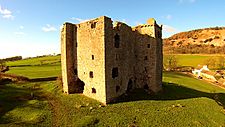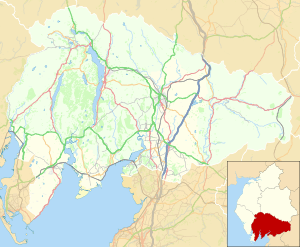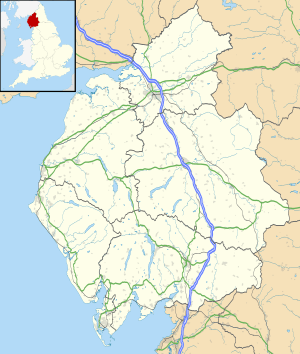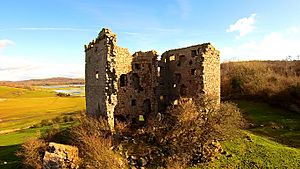Arnside Tower facts for kids
Quick facts for kids Arnside Tower |
|
|---|---|
| Cumbria, England | |

Arnside Tower
|
|
| Coordinates | 54°11′03″N 2°50′01″W / 54.1841°N 2.8335°W |
| Type | Tower house |
| Site information | |
| Owner | private |
| Open to the public |
no |
| Condition | Ruined |
| Site history | |
| Materials | Limestone rubble |
Arnside Tower is an old stone building called a tower house (or Pele tower). It was built a long time ago, in the late 1400s. You can find it in Cumbria, England, between the villages of Arnside and Silverdale. It's just south of a hill called Arnside Knott.
The Story of Arnside Tower
Arnside Tower was built in the second half of the 15th century. This was a time when many tower houses were built in northern England and southern Scotland. People built them because of a threat from groups called Border Reivers. These were families who often raided across the border, stealing cattle and other goods.
The tower was made from limestone rocks. It was originally five floors high and quite large, measuring about 50 feet by 34 feet. Arnside Tower also had an extra section, or "wing," built right next to it. This style was common for towers in Scotland but not so much in England. Some historians think its design might have been inspired by Ashby de la Zouch Castle.
In 1602, the tower had a serious fire. But it was fixed and people continued to live there. Some records suggest it was used until the late 1600s. Other records say that William Coward and his sister Agnes Wheeler lived there even later, at the end of the 1700s.
Around the year 1900, one of the tower's walls fell down. Today, Arnside Tower is a ruin. In 2014, English Heritage, an organization that looks after historic places, said the tower was in very bad shape and needed urgent repairs.
Arnside Tower is a very important historical site. It is listed as a Scheduled Monument. This means it's a nationally important archaeological site or historic building. It's also a Grade II* listed building, which means it's a building of special historical or architectural interest.
Visiting Arnside Tower

Arnside Tower is on private land, so you can't go inside or explore it up close. It's also quite ruined, so it wouldn't be safe.
However, you can still see the tower from a distance! The local tourist board suggests that you can get great views of the tower from a public walking path nearby. This path runs right alongside the tower, giving you a good look at this historic ruin.




